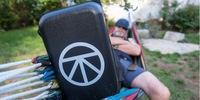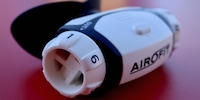

Six weeks until the half marathon: time to look after my legs
I set aside twelve weeks to prepare for a half marathon. At the six-week mark, I take a brief half-time break. And put the Blackroll Compression Boots to the test to see how they impact my recovery.
A month and a half ago, I started training for the Hallwilersee half marathon taking place on 14 October. After the initial basic phase, it was time for tempo runs and sprint interval training. It really helped me flourish. The longer runs, especially in the mountains, were my favourite. Because it was so fun, I’d keep running longer, faster or more often than my training plan required. My motto: anything worth doing is worth overdoing.
Recovery is part and parcel of success
But to avoid being tired on the starting line in six weeks’ time and having heavy legs from all my enthusiastic training, I give increasing thought to recuperation. After all, progress isn’t made during training, but during recovery periods in between. Muscles get tired during workouts and performance drops. Ideally, your body gets to recover during the resting phase. Micro-injuries heal and the body strengthens so it’s better prepared for the next training session or competition and can perform better.
This process is known as supercompensation. But if the workout was too intense and there’s not been enough recovery time, the body goes into a downward spiral. Instead of increased performance, you’ll witness fatigue, injuries, weakness and a lowered immune system. So it’s got nothing to do with compensation – and there’s certainly not anything super about it.
Signs you’re over-pushing yourself
As it happens, I’m in a phase where my muscles haven’t fully recovered. I can sense it in my heavy legs that pull a bit. What’s even more telling are the bioelectric impedance analysis (BIA) results. Here, body composition is measured using electrodes via your own alternating current resistance.
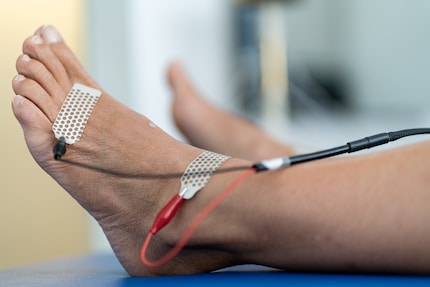
Source: Oliver Fischer
My BIA results show that I’m carrying too much water in my body, especially in my legs. This is a sign that I haven’t completely recovered. As that’s now three tests in a row that have given this result, I want to take the topic of recuperation more seriously from now on. Regularly going on runs for fun and out of cockiness wasn’t exactly smart – and now I’m reaping what I sowed.
Getting enough sleep and rest is very important for adequate recovery. Eating enough and a healthy diet (I still plan to get professional advice on this) also play their part. And massages. As I find that going for regular sports massages takes too much effort, I tested out the Blackroll Compression Boots as a massage substitute.

What are recovery boots?
Recovery boots are compression cuffs for the legs that exert varying pressure on the muscles and tissue with the help of air cushions. These cuffs are connected to an electric pump that’s built into the boot. The pump inflates and deflates the air chambers in the cuffs at set intervals. This presses the leg away from the foot and gives it some relief. As a result, blood can flow back from the feet and legs better. A similar technique is used in active recovery. Exercise stimulates blood flow to tired muscles and removes metabolic waste.
As I’ve already put a lot of strain on my muscles in training, any more exercise is out of the question right now. Instead, I can lie comfortably on the sofa or deckchair and let the compression boots do their work. All the while, I’ll read, listen to a podcast or watch a series. Very relaxing.
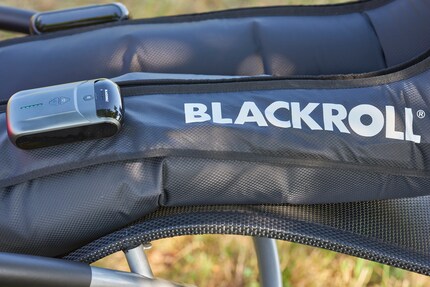
Source: Stefan Munsch
Blackroll explains that, as with active recovery through exercise, alternating pressure from the compression boots is designed to promote circulation, relieve sore muscles and ease heavy legs. In addition, the process is supposed to flush metabolic waste from the muscles and speed up the recovery process.
In fact, compression boots themselves aren’t anything new. There’s the [Normatec 3.0 Leg Recovery Boots] from Hyperice, for instance,(/s6/product/hyperice-normatec-30-leg-recovery-massagegeraet-23056629) and Therabody’s Recovery Air Jet Boots, which my colleague Patrick Bardelli has already reviewed. Now German recovery specialist Blackroll has also launched its own compression boots, which are cheaper than the models from Hyperice and Therabody.
First impressions
The Blackroll Compression Boots are well made and easy to put on and take off thanks to the full-length zip. Going by the manufacturer’s size chart, I went for size S, which also fit perfectly for my leg length. I really like the fact that the boots (1,160 g per boot including the battery) are light, compact and can be easily transported in the bag that they come with. It’s certainly a bonus for taking to competitions, training camps and stage races. Of course, it’s also a plus that they’re battery-operated, as this means I don’t need to be near a socket and can relax in the garden, for instance. One charge lasts for two 30-minute sessions at the highest setting. That’s usually enough, as I don’t think I’ll ever take the boots away for several days at a time on remote excursions without access to power. If that does ever happen, I can always buy spare batteries separately.
The boots boast five air chambers that allow pressure around the leg to build up from 40 to 120 mmHG. The upper limit equates to the systolic (higher) value of standard blood pressure.
A pleasant and relaxing massage
Operating the boots via the control unit is intuitive and simple. Once switched on, the control units for each leg connect automatically so the massage is synchronised on both sides. There are three different types of massage:
**–In mode 1, indicated by a blue light, the chambers fill with air from the foot to your thigh and then release in reverse order. Blackroll instructions explain that this type of massage is particularly effective for removing fluid and lactate after exercise.
**–In green mode, the air chambers pulsate while filling and emptying. This type of massage has been designed to promote blood circulation before and after workouts.
**–The yellow mode combines both types of compression and is versatile.
Each mode boasts five intensity levels that can be easily adjusted at the touch of a button.
After a longer run over the weekend (just under 22 km), I put the boots on in blue mode at the highest level. I found the compression incredibly comfortable and relaxing. The next day, I didn’t have any sore muscles.
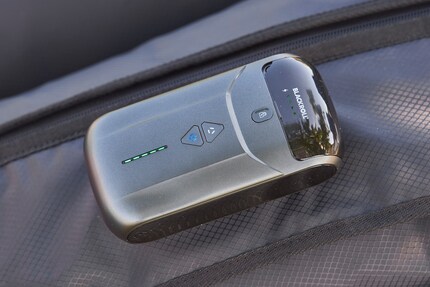
Source: Stefan Munsch
After using the boots about ten times, I’m left with a very good impression. I really like the way they massage my legs, and I don’t even have to leave the flat to get this kind of treatment. Given that my BIA score deems I have too much water in my legs, it’s particularly helpful that this compression is supposed to aid fluid removal. I also like the fact that the pump is relatively quiet. I’ll definitely be incorporating the boots into my half-marathon preparation as a recovery tool.
What does science have to say?
I found the sessions I spent wearing the boots both pleasant and relaxing. And that in itself impacted my recuperation. However it’s still scientifically inconclusive how much compression cuffs actually accelerate recovery and contribute to better athletic performance.
While one study of 56 ultramarathon runners indicated that compression massage resulted in less muscle pain and muscle fatigue, another study of ten long-distance runners concluded that air-pressure-controlled compression didn’t improve recovery. Another study with 12 participants concluded that air pressure-controlled compression during the recovery phase improves blood flow and thus possibly the removal of metabolites. One review, which admittedly only analysed three studies, concluded that compression boots may subjectively reduce muscle soreness in the short term but they couldn’t alleviate exercise-related muscle injuries in the longer term.
What does that mean in practice? Previous studies have shown that using boots improves some physiological factors such as blood circulation and that athletes have a more positive outlook. However, there still needs to be more research done into the impact compression boots have on athletic performance.
What does this mean for me now? Subjectively speaking, I find the massages very pleasant and they do me good. The boots also help me to rest and lie still after a run. My legs feel more relaxed and less tired after the massages in the inflatable leg warmers. And as subjective, mental factors also play a big part in training and recovery, I definitely see them as an additional benefit. I, for one, am looking forward to the next session with the huge moon boots.
Header image: Stefan Munsch
Research diver, outdoor guide and SUP instructor – I love being in, on and around water. Lakes, rivers and the ocean are my playgrounds. For a change of perspective, I look at the world from above while trail running or flying drones.
